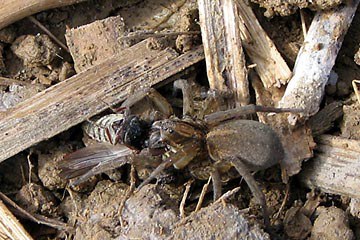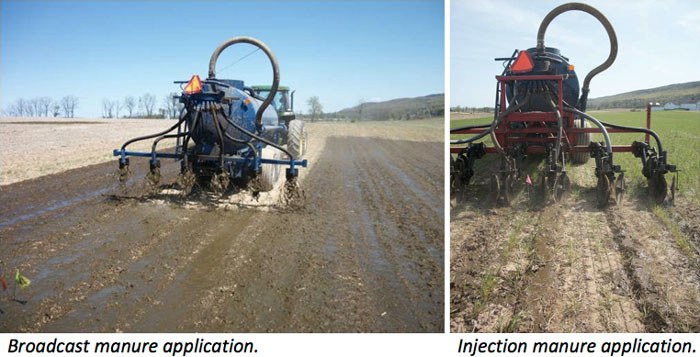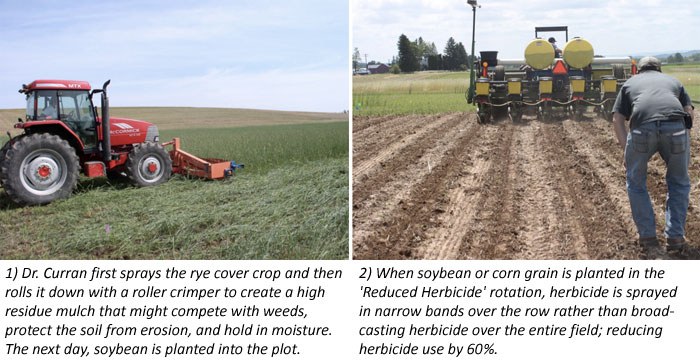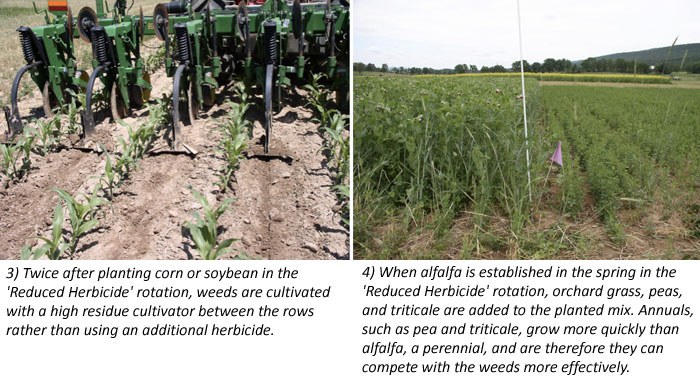To produce all of the food, forage, and fuel for our dairy farm, we designed two 6-year cropping rotations. We are evaluating strategies to improve manure management and weed management within the crop rotations. In the Forage Rotation, manure management strategies are compared, while in the Grain Rotation, weed management strategies are compared.
In both of our diverse cropping rotations, we use cover crops for multiple benefits, including providing habitat for beneficial organisms. Beneficial organisms include weed seed predators and pollinators, to name a couple of them. They can help keep certain herbivore pests in check (see picture to the right). In general, we strive to use integrated pest management (IPM) at our site, while also avoiding the use of restricted herbicides, such as atrazine.
In both rotations, canola is grown to provide fuel for a straight vegetable oil powered tractor and meal as a protein source for the dairy cow, while also providing cover over the winter. Canola is included in a different sequence in the two rotations, so that we can evaluate which rotation sequence is best for integrating canola into dairy crop rotations.

A wolf spider is eating a click beetle, which is the adult form of a wireworm, a pest on corn.
Forage Rotation

Manure Management Comparison: Manure is either broadcast onto or injected about 4-6 inches into the soil prior to planting corn silage and canola in the orage Rotation. Injecting manure has multiple benefits because it reduces ammonia volatilization (N loss), odor, and the risk of phosphorus surface run-off loss.

Nested within our manure management comparisons, we are also comparing green manure crop options.
Green Manure Comparison: In one year of the Forage Rotation, we are comparing two different green manure crops:
- red clover underseeded in winter wheat in spring,
- hairy vetch planted after wheat harvest.
We are comparing how well the legumes establish each year, compete with weeds, and provide nitrogen for the subsequent corn silage crop.
Grain Rotation

Weed Management Comparison: Weeds are managed in a variety of ways to reduce herbicide use in the Grain Rotation, including continuous cover cropping, using a roller crimper (image #1) to roll down cover crops and create a high residue mulch, and herbicides. Here, we are comparing a 'standard herbicide' practice with a 'reduced herbicide' approach; it includes:
- banding herbicide over the corn and soybean rows (image #2) and cultivating between the rows with a high residue cultivator (image #3)
- planting alfalfa and grass with triticale and peas in the spring (image #4)
- terminating the alfalfa once every 6 years with a plow instead of glyphosate


Where up to 8 herbicides applications might typically be applied in the 'standard herbicide'approach, in the 'Reduced Herbicide' cropping system we strive to reduce the number of herbicide applications to 2 full spray events and 2 banded herbicide events. Both banded herbicide events reduce herbicide use by 60 percent in each case.
Canola Mycorrhizae Comparison: Since canola is a non-mycorrhizal plant, it is grown with a nurse crop of oats in order to help maintain healthy levels of mycorrhizal inoculum in the soil.
Corn-Soy Grain Conventional Rotation

To evaluate the benefits of crop and insect diversity, we include a Corn-Soy Grain Conventional Rotation which use prophylactic insecticides and standard herbicides. This also allows us to compare broadcasting and injecting manure in no-till grain production.

